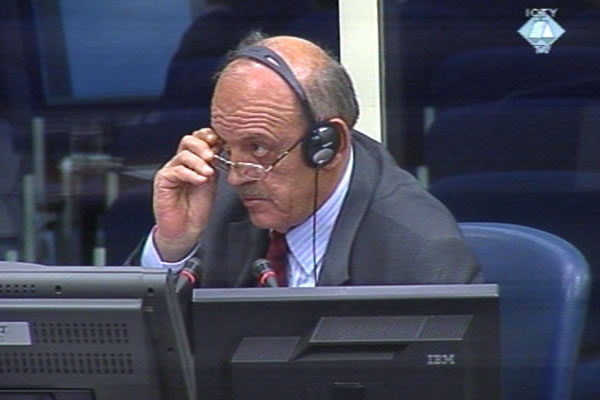Home
WITNESS ORDERED HIS SOLDIERS TO USE BOMBS HE KNEW NOTHING ABOUT
Former assistant commander in the Sarajevo-Romanija Corps Luka Dragicevic contends that he didn’t know that modified air bombs were launched on Sarajevo, although he himself ordered their use several times. In an eventful cross-examination, the witness admitted that the bombs were not launched from airplanes but didn’t know if they were launched from ‘the ground or a truck’ or maybe even from a ‘platform in the sea or a river’
 Milorad Sehovac, defence witness of Radovan Karadzic
Milorad Sehovac, defence witness of Radovan Karadzic Radovan Karadzic’s defense case continued with the evidence of three former soldiers from the Sarajevo-Romanija Corps. In their statements to the defense, the witnesses confirmed the defense case that the Bosnian Serb army did not attack civilians but military targets in Sarajevo. Since Karadzic is satisfied with tendering the written statements into evidence and asking a few questions, the main focus is on the cross-examination by the prosecution.
The first witness who completed his evidence was Colonel Milorad Sehovac. Sehovac claimed that the modified air bomb launched on 7 April 1995 on Hrasnica was aimed at Aleksa Santic primary school, which purportedly served as a factory producing weapons for the BH Army. The prosecutor noted the bomb fell about 150 m from the school building, killing a woman and injuring three other civilians. The prosecution alleges that civilians were indeed the target because then commander of the Sarajevo-Romanija Corps Dragomir Milosevic ordered the attack to inflict ‘the greatest human casualties and physical destruction’. Sehovac shifted the blame on the BH Army, claiming that it had to remove civilian population from the areas where there were military targets.
The next witness to testify was former VRS soldier and president of Srpsko Novo Sarajevo municipality, Milorad Katic. He tried to convince the Trial Chamber that some parts of the city, like Zmaja od Bosne Street where the Holiday Inn Hotel was, could have been attacked from the BH Army positions. In the cross-examination, the witness said that the area was clearly visible from the Metalka building where Serb snipers were deployed, as he stated in no uncertain terms. In the re-examination, Katic denied it, saying there were no soldiers in the building. This prompted the presiding judge Kwon to comment on the inconsistency. The witness gave third explanation, which was rather peculiar: during the war, the Bosnian Serb army soldiers lived with their families in the Metalka building but they definitely didn’t fire from their apartments on the citizens of Sarajevo.
The evidence of the third witness proved to be the liveliest. Luka Dragicevic, former assistant commander in the Sarajevo-Romanija Corps commander for morale and religious affairs was briefly examined in chief by the accused. He said that in the periods of lull in the fighting he organized courses of ‘morale and Serb tradition’ and of ‘law of war’. Prosecutor Nichols noted that Dragicevic had another, more important role, in the Corps.
Prosecutor Nichols first confronted the witness with his evidence in the case against Dragomir Milosevic, where Dragicevic said ‘I heard that air bombs were used’ in the attacks in Sarajevo but that he didn’t know anything about how they were launched. Dragicevic admitted at that trial that the Corps didn’t have any aviation. According to the prosecution, Dragicevic not only knew how the air bombs were fired, but on 2 September 1995 he in fact ordered that several such bombs be fired from a ground launcher on the city. The witness replied that he only signed the document as a ‘duty operations officer’ and didn’t know if the bombs were launched from the ‘ground or from a truck’. ‘But a truck is the same thing as the ground’, the prosecutor, asked, somewhat surprised by the answer. Dragicevic said that an air bomb could be fired from a ‘platform in the sea or a river’.
The prosecutor showed another document, dated the next day, in which the witness requested ‘urgent issuance’ of air bombs to brigades ‘so that they can be used quickly’.This was done to remove the bombs from depots which were under NATO air strikes, Dragicevic explained. The move ‘didn’t mean that they were meant to be used’. ‘You ordered that they be used immediately’, the prosecutor insisted, but the witness did not lose his calm, saying the document says, ‘so that they can be used quickly’, not ‘immediately’. The prosecutor smiled and soon declared he did not have any further questions.
The order issued by the witness while he was the chief of staff in the Visegrad Tactical Group in April 1994 was admitted into evidence. He ordered his subordinates to ‘burn down the village’ of Gojcevici. The witness explained that it was a hamlet with just three houses where the enemy positions were located. The prosecutor also tendered into evidence the 1991 census results that show Gojcevici was a village of 48 inhabitants, ‘more than three houses’. Dragicevic will complete his testimony tomorrow.
Linked Reports
- Case : Karadzic
- 2012-12-12 WITNESSES DEFEND KARADZIC AND THEMSELVES
- 2012-12-11 WHAT ARE THE ‘MOST PROFITABLE’ TARGETS?
- 2012-12-07 ‘TYPICAL TERRORISM’ IN SARAJEVO
- 2012-12-14 EXPLOSIVES EXPERT CONTESTS FINDINGS OF BALLISTICS EXPERT
- 2012-12-17 SHELLING ‘IN EXTREME NECESSITY’, ARMING ‘SPONTANEOUSLY’
- 2012-12-18 SUBPOENA FOR FORMER BOSNIAN POLICE OFFICER
